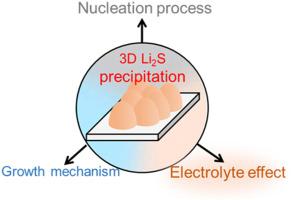当前位置:
X-MOL 学术
›
Particuology
›
论文详情
Our official English website, www.x-mol.net, welcomes your feedback! (Note: you will need to create a separate account there.)
Electrochemical deposition of Li2S2/Li2S in aprotic Li–S batteries
Particuology ( IF 3.5 ) Pub Date : 2024-02-02 , DOI: 10.1016/j.partic.2024.01.011 Zhifeng Yao , Xiaozhong Fan , Long Kong
Particuology ( IF 3.5 ) Pub Date : 2024-02-02 , DOI: 10.1016/j.partic.2024.01.011 Zhifeng Yao , Xiaozhong Fan , Long Kong

|
Lithium–sulfur (Li–S) batteries stand out the energy storage systems because of extremely high energy density (2600 W h Kg) and low-cost sulfur cathode. Unfortunately, the sluggish deposition from liquid Li polysulfides (LiPSs) to solid LiS leads to mild power density and short cycle life. Understanding and regulating LiS/LiS deposition are conceived to be importance to deliver second-plateau capacity in acceptable kinetics, which has the potential to operation Li–S batteries under electrolyte-lean conditions. This perspective aims to summarize the proposed models that can describe the nucleation and propagation of three-dimensional LiS/LiS, as well as affords critical views how electrolyte dictates LiPS conversion from liquid to solid. It hopes to encourage necessary scaffold strategies and electrolyte formulations to further improve energy density and life span of Li–S batteries.
中文翻译:

非质子 Li-S 电池中 Li2S2/Li2S 的电化学沉积
锂硫(Li-S)电池因其极高的能量密度(2600 W h Kg)和低成本的硫正极而在储能系统中脱颖而出。不幸的是,从液态多硫化锂(LiPS)到固态LiS的缓慢沉积导致功率密度较低和循环寿命较短。理解和调节 LiS/LiS 沉积对于以可接受的动力学提供第二平台容量非常重要,这有可能在贫电解质条件下运行锂硫电池。这一观点旨在总结所提出的模型,这些模型可以描述三维 LiS/LiS 的成核和传播,并提供电解质如何决定 LiPS 从液体到固体的转化的关键观点。它希望鼓励必要的支架策略和电解质配方,以进一步提高锂硫电池的能量密度和寿命。
更新日期:2024-02-02
中文翻译:

非质子 Li-S 电池中 Li2S2/Li2S 的电化学沉积
锂硫(Li-S)电池因其极高的能量密度(2600 W h Kg)和低成本的硫正极而在储能系统中脱颖而出。不幸的是,从液态多硫化锂(LiPS)到固态LiS的缓慢沉积导致功率密度较低和循环寿命较短。理解和调节 LiS/LiS 沉积对于以可接受的动力学提供第二平台容量非常重要,这有可能在贫电解质条件下运行锂硫电池。这一观点旨在总结所提出的模型,这些模型可以描述三维 LiS/LiS 的成核和传播,并提供电解质如何决定 LiPS 从液体到固体的转化的关键观点。它希望鼓励必要的支架策略和电解质配方,以进一步提高锂硫电池的能量密度和寿命。



























 京公网安备 11010802027423号
京公网安备 11010802027423号